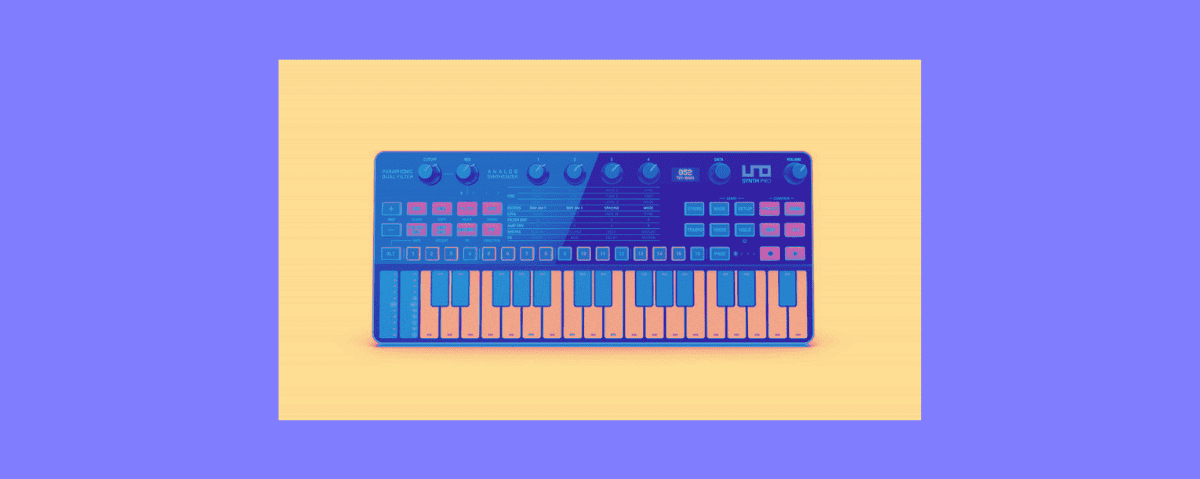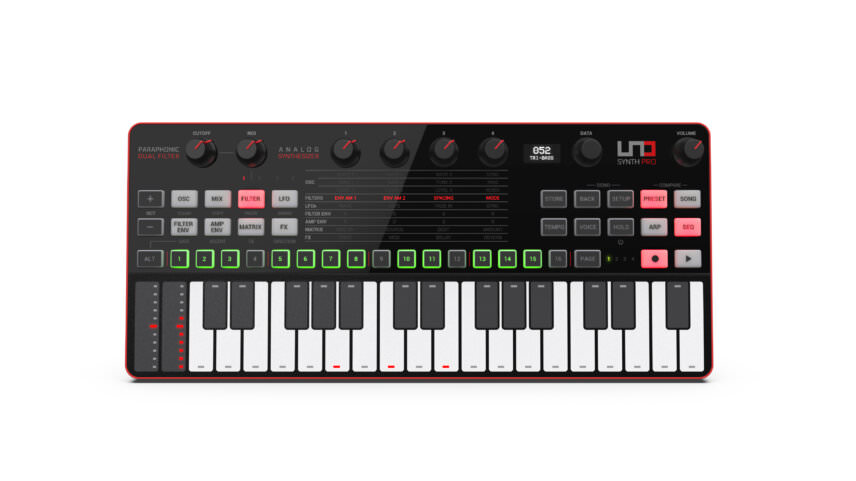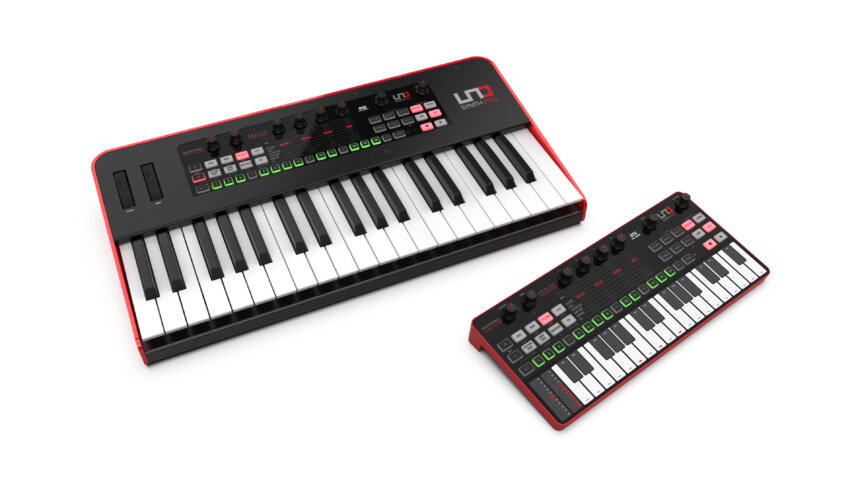
u-he are makers of award-winning software synthesisers and effects including Diva, Repro-1, Zebra2, Hive, Bazille, Presswerk and Satin.
Visit U-he

u-he are makers of award-winning software synthesisers and effects including Diva, Repro-1, Zebra2, Hive, Bazille, Presswerk and Satin.
Visit U-heWe use the onboard sequencer on the desktop model of IK Multimedia’s UNO Synth Pro to quickly whip up three house and techno basslines.
Unless you’re a hardcore DAWless jammer, we pretty much all rely on the sequencers in our DAWs. They’re powerful and centralized so why would ever need anything else? Well, there’s something to be said for programming with a synthesizer or drum machine’s built-in sequencer. They’re quick and immediate and a convenient way to get ideas down on the fly. They can also offer functionality that your DAW may not, like step sequencing. Finally, they’re part of the instrument’s design so they’ve likely been designed around the sequencer, and so sound pretty good with them.
IK Multimedia’s UNO Synth Pro features a 64-step sequencer with both real-time and step modes. It’s also polyphonic, meaning you can program in chords, although today we’re going to be ignoring this function in favour of making some basslines to use in house and techno tracks.
Here are the three basslines we’re programming:
Before we dive into programming, let’s first take a look at how the sequencer works. (We’ll touch a little on synthesis in this article but we’re not going to go deep, so if you need a refresher, check out these articles.) There are two versions of the UNO Synth Pro, the main and desktop. We’re using the desktop model today. The sequencer is the same in them both, however.

As we mentioned before, UNO Synth Pro has a 64-step sequencer. Sequences are divided into four pages of 16 steps, with active steps of the currently visible page indicated with lit buttons. To access a pre-recorded sequence, press the SEQ (sequencer) button and press play. Easy enough.
You can record sequences live or in steps. For live recording, press the SEQ button, then hold REC (record) and press the play button. As the sequencer moves through the 64 steps, play the keys live. The machine will quantize notes to sixteenths. The metronome can be configured in the Setup section. For step recording, press the REC button to activate the mode. Next, hold a step button to indicate its position on the timeline and then press a note to enter it.

To edit notes, you can use a combination of the ALT button and the secondary functions on the buttons to the left of the mod matrix. For example, to clear a note, press the ALT button once to engage the alternate functions, press and hold the OSC button (which is labelled CLEAR underneath it), and press the step with the note you want to cut. You can copy and paste in the same way. The ALT button also allows you to add accents and ties among other things.
Finally, you’re going to want to make sure that your sync settings are correct in both your DAW (if you’re using one) and the machine itself. Note that if you’re using the editor for synthesis tweaking, you’ll need to save any changes on the machine itself rather than on the editor. The editor doesn’t seem to recognize the onboard sequencer and will clear any sequencer data when you save.
Let’s get into it.
Let’s make a bassline inspired by Mr Fingers’ classic, ‘Can You Feel It’. We start with a square wave bass sound with a down-tuned second oscillator acting as the sub. The filter is fairly open to let plenty of harmonics through, with simple bass-appropriate ADSR settings. UNO Synth Pro has a strong effects section, so we use the Drive to beef up the bass a little and then Chorus to approximate the chorus effect on a Juno-60, the synth Larry Heard used for the track.
Let’s capture the bassline now using live recording. In the transport section, we press and hold the record button and then play and the sequencer starts running. We play in the six-note bassline, doing our best to hit the right beats. Unfortunately, our timing is less than perfect, and the note intended for step six has ended up in step seven. Let’s use the editing functions to fix this.
First, we press the ALT button to open access to the editing parameters. We could delete the note and then program it in step mode but as the note is correct, let’s use the editing functions instead to copy the note over to the correct step. First, we hold down the MIX button (its secondary function is copy) and press step seven. Next, we can paste it into step six by holding FILTER a.k.a. Paste and pressing step six. Lastly, we delete the note from step seven by holding OSC (clear) and pressing step seven.
That’s fixed the bad timing but at 64 steps, the sequence is too long. We can fix this while still in alternative parameter mode by pressing the OCT (octave) + button and then changing the length with the data encoder knob.
Here’s the bassline on its own:
And with some compression plus the beat ’07_CH_909_Drum_loop_3_120_Full.wav’ from the Splice pack, Classic House.
Next, let’s use the step sequencer to make a track inspired by the classic ‘Acid Trax’ by Phuture. To set up our acid bass, we use a single sawtooth oscillator tuned way down, a lowpass with lots of resonance, and an ADSR that favours the decay. We also use a little analogue drive to give the sound some oomph.
To program it, we put it in sequencer mode and then press the record button. First, we input the notes by holding each step number button in turn and assigning it an appropriate note. It’s a lot easier doing this on the UNO Synth Pro than an original Roland TB-303, that’s for sure. We do the accents next, first entering the alternate parameter mode by pressing ALT and then engaging AMP ENV (accent) and the notes that we want to affect. You can adjust the global accent amount from 1 to 127 with the data encoder. Lastly, we add in ties. First, we have to make sure UNO Synth Pro is in Legato mode. Next, we hit the MATRIX button for ties and then press the steps we want to add ties to. The tie will slur the selected note with the following one. Make sure that tie functionality is on by adjusting the data encoder.
Lastly, as before, we change the pattern length, this time to eight notes.
The finished acid bassline:
And in context with compression and the beat, ‘ah_drm120_mixtape_full.wav’ from Splice’s Acid House pack:
For our final bassline, let’s use the step sequencer again to make a monotone techno bassline. This one uses two oscillators, a sawtooth and triangle, with the triangle pitched up an octave. There’s also FM roughing things up. It’s using a single lowpass cutoff filter with plenty of resonance plus a basic envelope shape, with emphasis on the sustain for an extended feel. The effects really make this patch, with plenty of drive, a little flanger for movement and metallic texture, some ping-pong delay for width, and plenty of reverb.
This time, we don’t have any song in mind to emulate, so we use the step sequencer as an idea generator, punching notes into different steps and seeing how it lines up with the beat. We end up with a rhythmic, single note 16-step pattern with ties to connect some of the notes together.
Here is the bassline on its own:
And with compression and the beat, ‘tn_drm128_roughshod_ful.wav’ from the Splice pack, Techno.
Author Adam Douglas
15th October, 2021

u-he are makers of award-winning software synthesisers and effects including Diva, Repro-1, Zebra2, Hive, Bazille, Presswerk and Satin.
Download the demos and try them for yourself at www.u-he.com
Attack Magazine is funded by advertising revenue. To help support our original content, please consider whitelisting Attack in your ad blocker software.
x